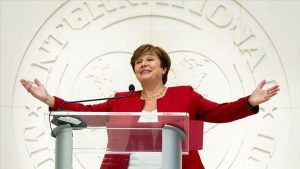THE International Monetary Fund (IMF) today raised its projections for global economic growth in 2021, the second time it has done so this year. This was made known today at the launch of the World Economic Outlook (WEO) during the ongoing Spring Meetings of the International Monetary Fund (IMF)/World Bank Group in Washington D.C.. The global institution followed
the trend of other private and public sector groups that have lifted their estimates for growth in the world’s gross domestic product. Many of those revisions have come as faster growth is seen for the U.S., which is the world’s largest economy. The Federal Reserve raised its estimate for U.S. GDP growth in mid-March to 6.5% in 2021, compared with its 4.2% forecast issued in December.
The IMF now forecasts the world economy will grow at a 6% annual rate, an increase from its January upgrade to 5.5% from the prior 5.2%. The IMF projects growth in the U.S. this year to be 6.4%.
“Even with uncertainty about the path of the pandemic, a way out of this health and economic crisis is increasingly visible,” Gita Gopinath, the IMF’s chief economist, said in announcing its World Economic Outlook report. “What we are seeing is multi-speed recoveries around the world.”
Gopinath noted the rosier forecast is largely the result of improved outcomes for the world’s most advanced economies, noting though that “recoveries are diverging” among and between countries.
Propelling this growth will be the American consumer, with pent up demand for services such as dining out, entertainment and travel, many economists believe. In addition, manufacturers and energy providers will ramp up to meet demand for high-ticket goods and increased mobility as more people become vaccinated against the coronavirus and global economic stimulus puts money in their wallets.
“We have upgraded our U.S. economic outlook again, to its highest possible rating, an A+,” Robert Dye, chief economist for Comerica, wrote on Monday. “We expect to see a rapid reflation of the U.S. economy over the remainder of this year, with strong momentum heading into 2022. The list of positive impulses is long. It starts with accommodative monetary policy in the form of very low interest rates, asset purchases and liquidity operations. We also now have three rounds of substantial fiscal stimulus in the system. Add in the ramp up in vaccinations, a rapidly improving labor market, huge pent-up demand, improving confidence and ample savings for consumer heaven in the near term. A proposed $2 trillion infrastructure plan, to be spent out over 7 years, would add to the economic expansion.”
Dye sees some potential bumps along the road to a full recovery, however, among them the possibility of rising interest rates, potential tax hikes by the Biden administration and increased pressures on global supply chains.
Even the struggling job market in the U.S. appears to have shrugged off its winter slump with 916,000 jobs being created in March, many of them in the hard-hit leisure and hospitality industries. On Monday, the Transportation Security Administration checked nearly 1.6 million flyers, compared with 108,000 on the same day last year and roughly 2.4 million for the same date in 2019.
A survey of global chief financial officers last month among 42 members in North America, Europe and Asia found a level of economic confidence not seen since 2018, with fear of COVID-19 half what it was in the fourth quarter of 2020.
“We’re now seeing a large snap-back in the economy,” says Michael Reynolds, investment strategy officer at Glenmede Trust. “It’s coming back with a vengeance.”

